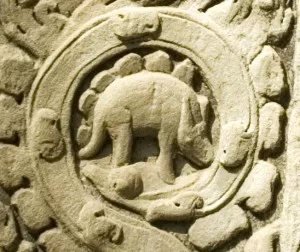Conventional science teaches that dinosaurs went extinct millions of years ago, either due to climate change or a catastrophic meteor impact. However, some researchers suggest that these ancient creatures might have survived in remote parts of the earth until much more recently. Intriguingly, a few even claim that small populations of dinosaurs may still exist in the world’s most isolated forests.
Recently, a reader shared with All News Web a fascinating discovery at the Ta Prohm Temple in Cambodia. This ancient temple, constructed by the remarkable Khmer civilization between the 800s AD and the 1400s AD, is known for its intricate carvings. During a visit, the reader noticed carvings that appear to depict a Stegosaurus, a dinosaur that conventional science asserts went extinct around 155 million years ago.
The Enigmatic Temples of Angkor Wat, Angkor Thom, and Bayon
The temples of Angkor Wat, Angkor Thom, and Bayon are among Cambodia’s most iconic landmarks. These architectural marvels, located in the Siem Reap province, showcase the grandeur of the Khmer Empire. Visitors from around the world flock to these sites to marvel at their intricate carvings, massive stone structures, and historical significance.
Angkor Wat: The largest religious monument in the world, Angkor Wat is a stunning example of Khmer architecture. Originally constructed as a Hindu temple dedicated to Vishnu, it gradually transformed into a Buddhist temple by the end of the 12th century. The temple’s central tower, surrounded by four smaller towers, symbolizes Mount Meru, the center of the universe in Hindu and Buddhist cosmology.
Angkor Thom: Known as the “Great City,” Angkor Thom served as the last capital of the Khmer Empire. Enclosed by a massive wall and a moat, it features the Bayon Temple at its center. The city’s gates, adorned with giant stone faces, lead to a complex filled with temples, terraces, and other structures.
Bayon: The Bayon Temple, famous for its serene and smiling stone faces, is located in the heart of Angkor Thom. Built in the late 12th century by King Jayavarman VII, it stands as a symbol of the king’s devotion to Buddhism. The temple’s 54 towers, each with four faces, represent the 54 provinces of the Khmer Empire.
Traveling Distances and Staying in Cambodia
Traveling Distances: Angkor Wat is located approximately 5.5 kilometers (3.4 miles) north of Siem Reap. Angkor Thom is just a short distance further north, and the Bayon Temple is situated within Angkor Thom itself. The distances between these sites are relatively short, making it convenient for travelers to explore all three in a single visit.
Staying in Cambodia: Siem Reap offers a wide range of accommodation options, from budget hostels to luxury hotels. Staying in Siem Reap allows easy access to the temples and other attractions in the region. Popular hotels include the Sofitel Angkor Phokeethra Golf and Spa Resort, Shinta Mani Shack, and Lotus Blanc Resort. Many hotels offer guided tours to the temples, ensuring visitors get the most out of their experience.
The Mysterious Stegosaurus Carving
The Ta Prohm Temple, also part of the Angkor Archaeological Park, is renowned for its picturesque scenery with trees growing out of the ruins. However, it’s the mysterious Stegosaurus carving that has sparked significant intrigue. The carving appears to show a creature with a row of kite-shaped plates along its back, remarkably similar to the Stegosaurus.

Stegosaurus: This dinosaur, known for its distinctive back plates and spiked tail, roamed North America during the Late Jurassic period. Conventional science asserts that the Stegosaurus went extinct around 155 million years ago. Yet, the carving at Ta Prohm raises questions about whether these ancient creatures could have survived longer than previously thought.
Local Traditions and Expert Opinions
Local villagers near the Ta Prohm Temple claim that traditions of this animal have persisted until relatively recent times. These stories add to the mystery surrounding the Stegosaurus carving. An expert on Khmer ruins noted that it is unlikely the carving was a recent addition, further fueling speculation about its origins.
Exploring the Cambodian Dinosaurs Theory
The theory that dinosaurs might have survived into the Khmer era is controversial and not widely accepted by mainstream science. However, it raises intriguing questions about our understanding of history and the natural world. Could the Khmer civilization have had contact with creatures that were believed to be long extinct? Or is the Stegosaurus carving merely a coincidental resemblance?
Conclusion
The temples of Angkor Wat, Angkor Thom, and Bayon are not only architectural masterpieces but also gateways to the mysteries of ancient Cambodia. The potential depiction of a Stegosaurus at Ta Prohm adds a layer of intrigue to these historical sites. Whether a coincidence or evidence of something more profound, the carving captivates the imagination and invites visitors to explore the rich tapestry of history and legend woven into the Cambodian jungle.
When planning your visit, ensure you stay in comfortable accommodations in Siem Reap and take the time to fully explore these incredible temples. Who knows what other secrets you might uncover in the heart of Cambodia?

